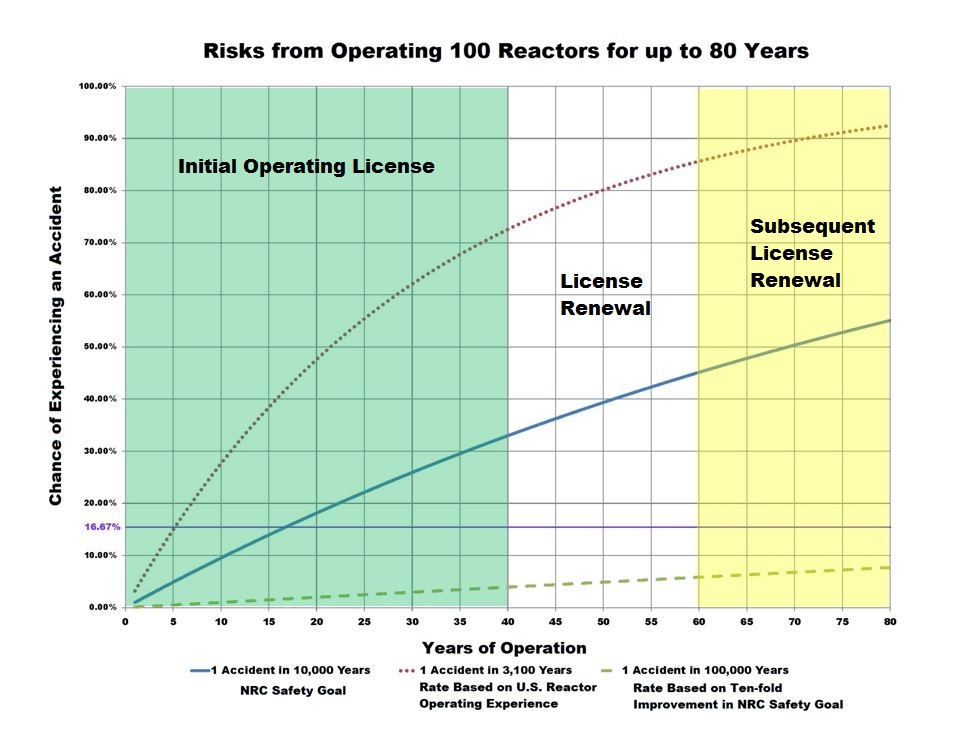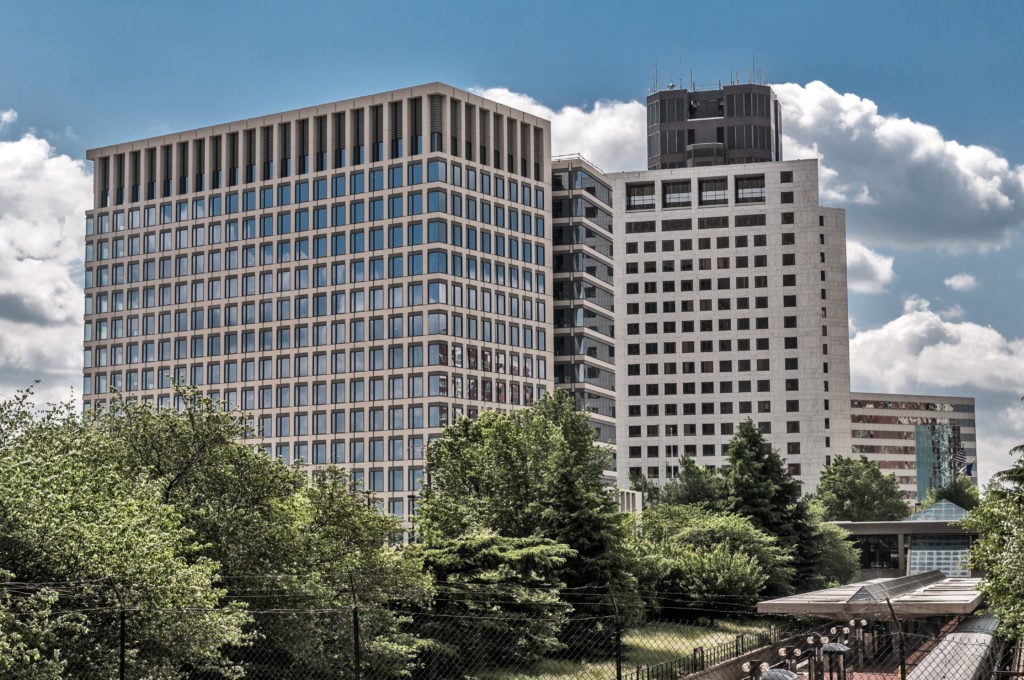Fission Stories #193
The Nuclear Regulatory Commission (NRC) initially licenses nuclear power reactors for operation up to 40 years. The NRC can renew the operating licenses for up to 20 additional years, as it has already done for about three quarters of the reactors in the United States. And the nuclear industry is discussing “subsequent license renewal” with the NRC for potentially 20 more years.
What are the risks?
Risks from operating a fleet of 100 reactors for 80 years are plotted in Fig. 1. The green-shaded area on the left represents the initial 40-year operating license term. The white are in the middle represents the 20-year renewed license period. And the yellow-shaded area on the right represents another 20 year period from subsequent license renewal. (If this green/white/yellow color scheme representing increasing nuclear plant risks infringes on the NRC’s Reactor Oversight Process copyright, please call Junior at BR-549.)
Risks are plotted using three different accident rates. The first is shown by the solid blue line and is based on a risk of 1×10-4 per reactor year (also denoted as 10E-4 / reactor-year) derived from the NRC’s Safety Goal policy statement. That risk can also be expressed as one reactor accident every 10,000 years.
The second risk is shown by the dotted red line and is based on the actual operating experience in the United States—the March 1979 meltdown of Three Mile Island Unit 2 among roughly 3,100 years of operation by all other nuclear power reactors in the country.
The third risk is shown by the dashed green line and is based on a ten-fold improvement in the NRC’s Safety Goal. In other words, it is entirely speculative.
What are the initial (40-year) risks?
From a fleet of 100 reactors operating at the NRC’s Safety Goal risk, there’s about a one-in-three chance (32.97% to be precise) that one reactor accident occurs during the 40-year initial license term. The chances of experiencing a reactor accident soar to nearly three-out-of-four (72.5%) from a fleet operating at the U.S. nuclear industry’s demonstrated risk level. But a ten-fold improvement in the NRC’s risk goal reduces the chances to less than one-in-twenty-five (3.9%).
Superimposed on the chart is a horizontal purple line at 16.67% risk. This risk corresponds to a one-in-six chance of reactor accident—the same risk as losing at Russian roulette with one bullet loaded in a six-chamber revolver. The 100-reactor fleet reached this risk range after only five years at the U.S. nuclear industry rate. It took a little longer—17 years—to get there at the NRC Safety Goal. A ten-fold improvement in the Safety Goal prevents this risk from being reached by 100 reactors operating for 80 years. But again, this safety level is purely speculative.
What are the renewed (60-year) risks?
As the chart and numbers reflect, it’s possible for a fleet of 100 reactors to operate for 40 years without any of them experiencing an accident. Renewing their licenses for 20 more years sustains that possibility. But it also ups the chances of experiencing an accident.
The chance of a reactor accident among a 100-reactor fleet operating for 60 years at the NRC’s Safety Goal approaches 50-50 (45.1%).
The chances of a reactor accident among a 100-reactor fleet operating for 60 years at the U.S. nuclear industry accident rate climbs to 85.6%.
100 reactors operating for 60 years at a ten-fold increase in the NRC’s Safety Goal yields only a 5.8% chance of a reactor accident. Purely speculative, but much better odds.
What are the subsequent (80-year) risks?
If a fleet of 100 reactors operates for 80 years at the NRC’s Safety Goal, there’s better than a 50-50 chance (55.07%) that one will experience an accident.
That same 100-reactor fleet operating at the U.S. nuclear industry accident rate for 80 years has better than a nine-out-of-ten chance (92.5%) of experiencing a reactor accident.
And the entirely speculative case of the 100-reactor fleet operating for 80 years at a ten-fold improvement of the NRC’s Safety Goals has a small chance (7.7%) of having an accident among them.
Our Takeaway
I’m not aware of any Russian Roulette Hall of Fame commemorating late great rouletters like Fast Freddie Enright with his amazing 75-8-2 record. The reason for this lack is probably explained in the 1983 feature film War Games starring Matthew Broderick, Dabney Coleman, and Ally Sheedy where the only way to win is not to play.
The risk from operating 100 reactors for 40 years at the NRC’s Safety Goal is slightly greater than the risk from taking two spins at Russian roulette.
The risk from operating 100 reactors for 40 years at the U.S. nuclear industry’s demonstrated accident rate is slightly greater than taking seven spins at Russian roulette using a six-chamber revolver.
The risk from operating 100 reactors for 80 years at the NRC’s Safety Goal is a tad under the risk from taking five spins at Russian roulette (it’s about 4 ½ spins, but I’m not sure what half a spin is and know I don’t want to learn about it.)
The risk from operating 100 reactors for 80 years at the U.S. nuclear industry’s demonstrated accident rate is slightly over the risk from 14 spins at Russian roulette.
The risk from operating 100 reactors for 80 years with a ten-fold improvement in the NRC’s Safety Goal is less than half the risk from taking a single spin at Russian roulette.
How many people would like to take 4 ½ to 14 spins at Russian roulette? That’s about the same risk of experiencing a reactor accident from a fleet of 100 reactors operating for 80 years.
If you must play nuclear roulette, the second best way to dodge a bullet is to take every reasonable step to lower nuclear plant risks.
Plant owners seeking license renewal identified numerous cost-beneficial safety updates in the Severe Accident Mitigating Alternative (SAMA) evaluations. But the NRC did not require that owners implement these risk-reducing measures. Instead, they told the owners to take another spin.
And the NRC does not even currently require that plant owners pursuing subsequent license renewal go through the charade of using SAMA evaluations to identify risk-reducing measures that don’t have to be taken. Instead, the NRC seems ready to tell the plant owners to take two more spins.
I’m mistaken. There is a Russian Roulette Hall of Fame after all. It turns out I’ve even visited the place. It’s called U.S. Nuclear Regulatory Commission headquarters.
“Fission Stories” is a weekly feature by Dave Lochbaum. For more information on nuclear power safety, see the nuclear safety section of UCS’s website and our interactive map, the Nuclear Power Information Tracker.




